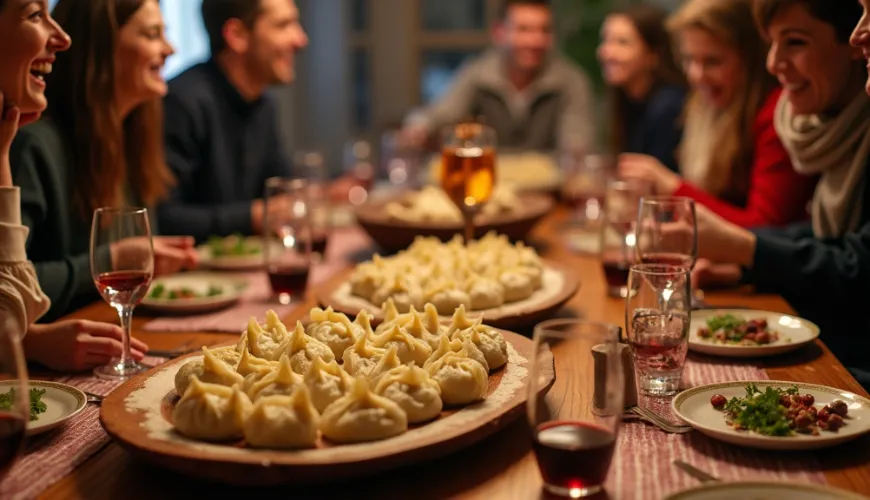
How to Make Original Khinkali at Home and Surprise Your Friends

Chinkali - Georgian Dumpling Tradition Conquering Global Cuisines
When one mentions Georgia, many people envision the picturesque Caucasus mountains, hospitable people, and rich, spicy food. However, few dishes capture the Georgian spirit as perfectly as chinkali – juicy dumplings filled with meat that have become a symbol of the national cuisine. Although they may initially resemble Asian dumplings like Chinese baozi or Central Asian manty, chinkali have their unique origin, tradition, and method of preparation.
The Origin and History of Chinkali
Chinkali (often transcribed in Czech as "chinkali" or "khinkali") originate from the mountainous areas of northern Georgia — specifically from the regions of Khevsureti and Mtskheta-Mtianeti. It was there, in the harsh conditions under the Caucasus, that a dish was created to be nutritious, easily storable, and conveniently transportable for long journeys. When shepherds and warriors set out into the mountains, they needed something that would satisfy and energize them. And chinkali, with its rich meat filling and broth inside, became the ideal travel food.
With growing popularity, the recipe for chinkali spread across all corners of Georgia, bringing with it various filling variations — from the classic meat mixture to vegetarian versions filled with mushrooms, potatoes, or cheese.
What Exactly are Chinkali?
At first glance, they look like elegant bundles of dough. Inside, however, lies a juicy filling made from a mixture of minced meat (most commonly beef and pork, sometimes lamb), fresh herbs, spices, and water or broth, which turns into a delicious juice during cooking. This broth is what makes chinkali special – when prepared correctly, a pocket of hot meat broth forms inside the dumpling, which must be carefully sipped before enjoying the rest of the dish.
One of the unwritten rules when consuming chinkali is that they are eaten by hand, without cutlery. Chinkali are held by the top dough knot, which is usually not eaten, and bitten into to open. This is followed by sipping the hot broth before eating the rest of the dumpling. It's part ritual, part skill – and definitely an experience.
How to Prepare Chinkali at Home
Although preparing chinkali may seem complex, with a bit of patience and practice, anyone can master it. It's important to follow a few key steps to ensure that the final dish is authentic and tasty.
Basic Chinkali Recipe (for 4 people)
For the dough:
- 500 g plain flour
- about 250 ml water (as needed)
- a pinch of salt
For the filling:
- 300 g minced beef
- 200 g minced pork
- 1 medium onion, finely chopped
- a handful of fresh coriander or parsley
- salt, freshly ground pepper
- about 100 ml cold water or broth
Start with the dough. Salt the flour, add water, and work into a smooth, elastic dough, which you let rest for at least 30 minutes. Meanwhile, prepare the filling by mixing all the ingredients. It's important to add enough liquid — this will turn into juice during cooking, so the filling should be moist but not runny.
Roll the dough into a sheet and cut out circles (about 12 cm in diameter). Place a spoonful of filling in the center of each circle and gradually pleat the edges into folds – typically 15 to 20 pleats, which are joined at the top into a knot.
Boil the dumplings in salted boiling water for about 10 minutes until they float and soften.
When serving, they are often lightly sprinkled with freshly ground pepper – no sauces, no sides. Chinkali are a rich and complete meal on their own.
Vegetarian and Modern Variants
With the increasing interest in plant-based diets, vegetarian versions of chinkali are appearing. Popular fillings include sautéed mushrooms with fried onions, mashed potatoes with caramelized onions, or a mixture of Georgian cheeses. This allows the traditionally "meaty" dish to become a versatile meal that practically anyone can enjoy – whether they eat meat or not.
In some modern restaurants, baked chinkali are also appearing, which, instead of being steamed or boiled, are baked in the oven for a crispy surface. Although this version may seem unorthodox to purists, culinary experiments show that chinkali can adapt to new tastes while remaining true to their origins.
A Symbol of Culture and Hospitality
Chinkali are not just a dish but also a part of Georgian dining culture. In Georgian households and restaurants, they are usually served at large feasts called supra, where singing, wine toasting, and passionate conversation take place. Every guest has the opportunity to enjoy several hot dumplings straight from the pot, with an emphasis on shared enjoyment and the joy of dining together.
According to local tradition, the skill of the cook is judged by the number of pleats on the dumpling – the more, the better. Master chinkali makers can reportedly manage up to 30 pleats per piece.
Chinkali in the Czech Republic
Chinkali are also finding their place here. In some cities, specialized Caucasian restaurants have emerged where authentic chinkali can be tasted. But even home cooks are increasingly daring to prepare them — and it's no wonder. The combination of simplicity, honesty, and intense flavor appeals even to those who are not typically fans of Georgian cuisine.
For instance, in the city of Plzeň, a small family restaurant recently opened, run by a Georgian couple. Their homemade chinkali, prepared according to their grandmother's recipe, have become a local hit within a few months. People take them home in boxes, frozen, or enjoy them with a glass of quality wine.
One visitor recently wrote on social media: “I never would have believed that so many flavors could fit into a dumpling. Chinkali are like a little treasure on a plate for me."
A Step Closer to Sustainability
Although chinkali are not typically an eco-friendly dish, preparing them at home can be a step towards more sustainable cooking. We avoid plastic packaging from ready-made products, know exactly what we're eating, and have the option to choose local and quality ingredients — whether it's meat from a farmer or organic herbs from our garden.
Another advantage is that we can prepare chinkali in advance and freeze them – making them a quick, delicious dinner even when there's no time or inspiration for cooking.
Whether you decide to taste them in a restaurant or prepare them at home according to the traditional chinkali recipe, one thing is certain: you'll experience the taste of Georgia in its most generous form. Not just as food, but as an experience that brings people together at one table.

